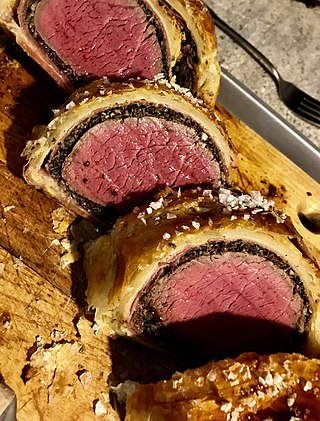Top Qs
Timeline
Chat
Perspective
Beef Wellington
English steak dish From Wikipedia, the free encyclopedia
Remove ads
Beef Wellington is a baked steak dish of English or French origin, made out of fillet steak and duxelles wrapped in shortcrust pastry. Some recipes include wrapping the contents in prosciutto, or dry-cured ham, which helps retain moisture while preventing the pastry from becoming soggy; use of puff pastry;[1] or coating the beef in mustard. Classical recipes may include pâté.[2]

A whole tenderloin may be wrapped and baked, and then sliced for serving, or the tenderloin may be sliced into individual portions before wrapping and baking.[3]
Remove ads
Naming
Summarize
Perspective
While historians generally believe that the dish is named after Arthur Wellesley, 1st Duke of Wellington, the precise origin of the name is unclear and no definite connection between the dish and the duke has been found.[4]
Leah Hyslop, writing in The Daily Telegraph, observed that by the time Wellington became famous, meat baked in pastry was a well-established part of English cuisine, and that the dish's similarity to the French filet de bœuf en croûte (fillet of beef in pastry) might imply that "beef Wellington" was a "timely patriotic rebranding of a trendy continental dish".[5] However, she cautioned, there are no 19th-century recipes for the dish. There is a mention of "fillet of beef, à la Wellington" in the Los Angeles Times of 1903, and an 1899 reference in a menu from the Hamburg-America line.[6]
In the 1910 Polish cookbook Uniwersalna książka kucharska ("The Universal Cooking Book") by Maria Ochorowicz-Monatowa (1866–1925), there is a recipe for "Polędwica wołowa à la Wellington" ("beef fillet à la Wellington"). The recipe does not differ from the dish later known under this name. It is a beef filet enveloped together with duxelles in puff pastry, baked, and served with a truffle or Madeira sauce. The author, who mastered her cooking skills both in Paris and Vienna at the end of the 19th century, claimed that she had received this recipe from the cook of the imperial court in Vienna. She also included "filet à la Wellington" in the menus proposed for the "exquisite dinners".[7][8]
In Le Répertoire de la Cuisine a professional reference cookbook published by Théodore Gringoire and Louis Saulnier in 1914, there is mentioned a garnish "Wellington" to beef, described as: "Fillet browned in butter and in the oven, coated in poultry stuffing with dry duxelles added, placed in rolled-out puff pastry. Cooked in the oven. Garnished with peeled tomatoes, lettuce, Pommes château".
An installment of a serialized story entitled "Custom Built" by Sidney Herschel Small in 1930 had two of its characters in a restaurant in Los Angeles that had "beef Wellington" on its menu.[9] The first occurrence of the dish recorded in the Oxford English Dictionary is a quotation from a 1939 New York food guide with "Tenderloin of Beef Wellington" which is cooked, left to cool, and rolled in a pie crust.[5]
Remove ads
Variations
In the Food Network show Good Eats, Alton Brown discusses a variant using the cheaper pork tenderloin instead of beef.[10] A common vegetarian variation of the dish, known as "beet Wellington", replaces the beef with beetroot and has been featured on food competition shows such as MasterChef Australia.[11][12]
See also
References
Wikiwand - on
Seamless Wikipedia browsing. On steroids.
Remove ads

